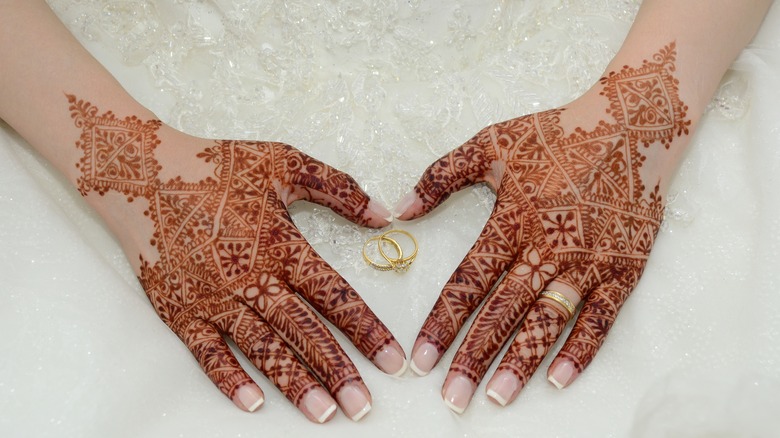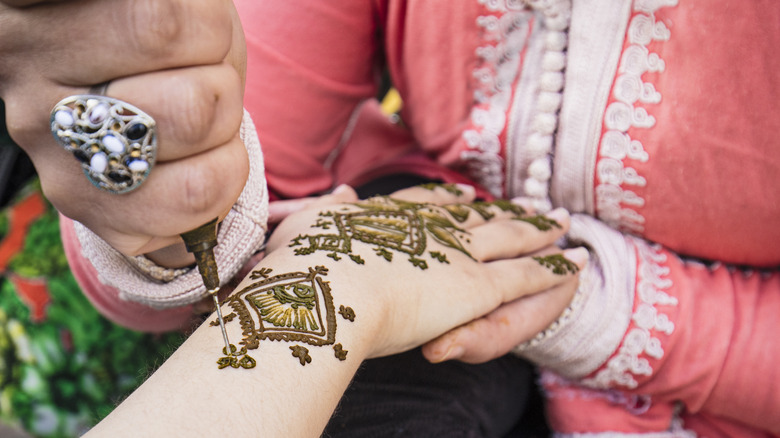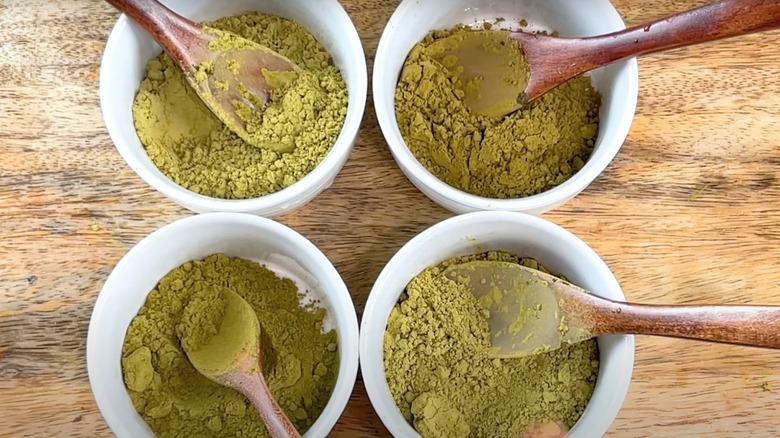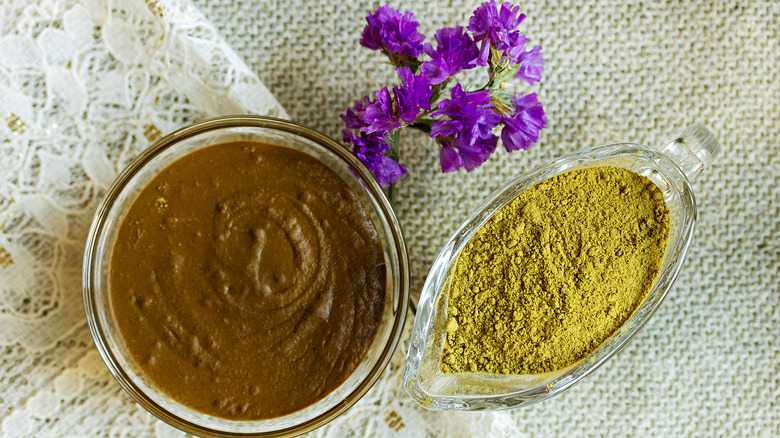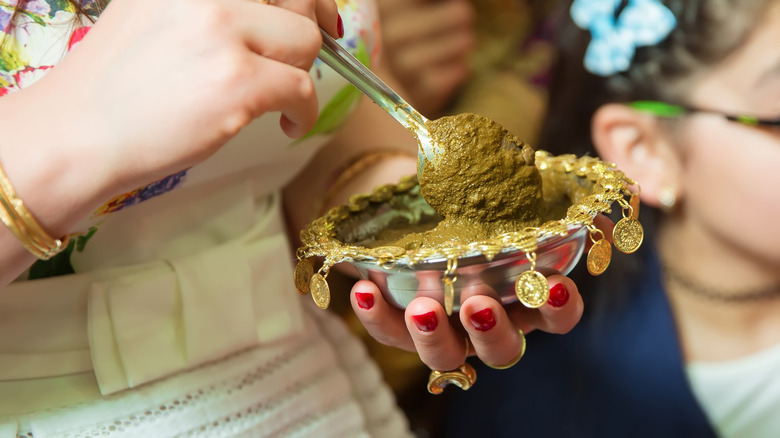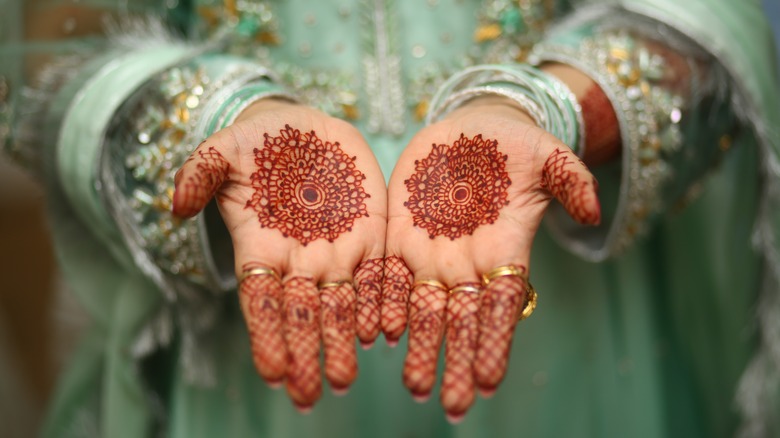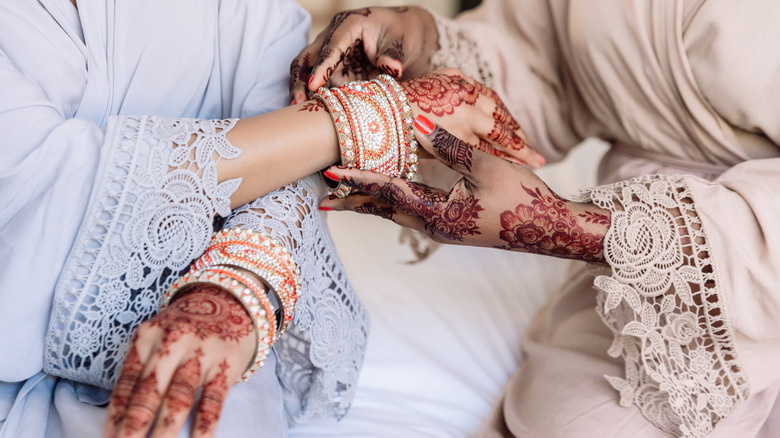Everything You Need To Know About Henna Tattoos
Henna art is becoming more and more popular, but it has been around for a long time. The "ink" used for henna tattoos, which are not permanent, comes from a plant of the same name. Not only is the dye created from the henna plant used for temporary tattoos and hair dye but it is also used as a dye for certain fabrics. You can even use it to color your fingernails. The pigment in this plant's leaves that makes that reddish-brown color is called lawsone, according to the Natural History Museum, which can vary some in hue.
The art of henna has been used in many ceremonies and is popular in Hindu and Muslim cultures. The designs made with henna can range from intricate patterns that look like mandalas to floral designs that bring spring to mind. Along with picking the right powders, learning to do henna tattoos, and what situations one might want to use henna as part of a ritual, learning the rich history of this interesting plant dye is also important before diving in.
The history of henna tattoos
As stated, henna has been around for a long time — thousands of years. "It's hard to pinpoint exactly where henna originated from since people in Africa, Egypt, the Middle East and India were using it over 5,000 years ago," Neha Assar, chief executive artist at Neha Assar Henna Artistry in LA, tells HowStuffWorks. Weddings, birthdays, and special celebrations are events where you would likely see henna tattoos in some cultures.
Those living in hot climates used the paste from the henna plant on their feet to help cool themselves off, as the mixture would offer this effect as it dried. St. Thomas University mentions that the paste may have been used as a topical treatment for many ailments, including upset stomach and wound healing. There are some reports that even Cleopatra used henna as a way to adorn her skin. Because it comes from a plant, it was available to people no matter how much or how little money they had.
Doing some research on the designs and cultural significance may be a good idea before diving head-first. "It's important for clients to note that symbolism in many henna designs is sacred," henna artist Mangala Bühler-Rose tells HowStuffWorks. "Some communities even consider the substance itself to be sacred. Thus, henna and symbols are used respectfully, sensitively and knowledgeably. For example, placing an image of the deity Gaṇeśa on the feet would be considered disrespectful." Honoring the traditions and sacredness of henna goes hand-in-hand with the art, so be sure to wear it with good intentions!
Some of the best places to get a henna tattoo
When you're looking to get a henna tattoo, the place to get it has no limits, but there are some things that you can consider to assist in making your tattoo last longer. Because it goes on as a paste, you'll likely want it in an area that can be left uncovered for some time until the paste flakes off. If you get your henna tattoo somewhere that clothing rubs constantly, the friction could also wear the tattoo away faster.
It's best to pick areas where it's most visible, especially if you want to show off your henna art. Think of the most meaningful places. Some expecting mothers get henna art on their bellies. Wedding traditions have women getting henna art on their hands and arms. During the summer, when you're more likely to wear sandals and open-toed shoes, henna tattoos on the feet can be fun and cooling.
Really, anywhere you get any actual tattoo will work, but if you want to show them off, wear clothing that does that — like an off-the-shoulder top for shoulder henna, crop tops for stomach and lower back henna, and shorts or short skirts if you have henna on your legs. If you're brave enough, you can also sport henna tattoos on your face in the form of henna tattoo freckles.
How to pick the right henna powder
Not all henna powders are created equally, so if you want the best results from your henna tattoos, it's important to make sure you buy the best. That doesn't mean you have to buy the most expensive product but rather know about the company and what they're selling.
One important thing to look for is how fresh the henna powder is — the fresher, the better. While henna powder can be good for a long time if kept frozen, you definitely want to pass on expired products, as they may not work as well. You want to invest in products that were stored properly as well — out of direct sunline and stored in a cool place (or frozen).
Buying your henna online is a little more difficult, as you can't do things like the smell test to see if it smells natural and earthy (good!) or chemically (not good!). If you do buy online, know your return policies so you can send back anything that seems sketchy. You can purchase henna kits with everything you need to get started, but look for handmade kits with powder that isn't factory-made to avoid those unwanted added chemicals.
Know your henna ingredients
You want to always be sure your henna powder is safe, whether you're using it on yourself or someone else. This means that you want to know what is in it, and if it doesn't have an ingredient list available, consider reaching out to the person selling it.
If you're not doing the henna yourself, but getting it done somewhere, don't be afraid to ask them where they get their powder from and what ingredients are in it — you can even ask to see the container it came out of for your own safety. If they don't want to show you or don't know, it may be time to consider looking for a different henna artist.
Your henna powder should have all-natural ingredients. A good henna powder will contain only natural henna powder, but you may find others with a longer list of ingredients, including different herbs. What you want to avoid are ingredients that come from added chemicals, which can be harmful when used on the skin. Reactions from organic henna are rare — henna laced with chemicals, on the other hand, can cause issues like blistering, itching, redness, and scarring (via Minnesota Department of Health).
Beware of black henna
One ingredient you want to absolutely avoid is PPD (paraphenylenediamine), also called p-phenylenediamine, which is a chemical ingredient added to henna to make it black. Natural henna should not be black. While you may love the goth, dark look, you definitely want to avoid this additive when applying henna on the skin.
While this ingredient is often added to hair dyes — and is FDA-approved for that use — this ingredient is a skin allergen to some and can be harmful when applied to the skin (per the Journal of Clinical and Aesthetic Dermatology).
The FDA notes that PPD can cause "dangerous skin reactions" and is "not approved for direct application to the skin." While it may seem fun to try a different color of henna ink, you want to keep your safety and the safety of anyone else getting henna work from you in mind. If you are getting henna art done by someone else and the color of their mix is black, don't be afraid to speak up about it.
How to mix your henna
When it's time to mix your henna for application, you'll need more than just your henna powder. There are hundreds, if not thousands, of recipes online for mixing henna, so you can do a little research to find the one that appeals the most to you.
Some recipes call for mixing your henna powder with sugar, water, and your choice of essential oils (be sure to pick ones that are safe for use on your skin), while others have you skip the sugar. Some also have you include lemon juice. Whatever recipe you follow, including the one on the henna package, you'll want to mix your henna well until it is like a pudding-like paste. Then you'll transfer it into an application cone.
There is one thing to consider when it comes to mixing your henna paste — watch what type of bowl you choose to stir it in. The Henna Page suggests not using metal bowls for stirring because the henna can "react with some metals and tarnish them." Stainless steel is okay to use, but a glass or ceramic bowl is an easy choice if you're unsure. If you think you'll have some leftover ink, mix it in a container with a solid lid for later storage.
How to apply henna
Depending on how intricate the design is, a henna piece could take anywhere from a few minutes to a few hours. If you're getting your entire tummy decorated or both hands and feet, expect to sit for a bit. Most artists freehand henna designs, unlike getting a real tattoo where a stencil is often used.
Additionally, you want to be sure that the paste is coming out of your cone evenly and smoothly so your lines and dots look nice and uniform. Don't press firmly on the skin — instead, lift the cone just above the skin slightly. For thicker lines, instead of pressing harder on the cone (which can give you messy lines), create two thin lines and fill them in. When creating dots, ensure you are holding the cone in an upright position.
The big part is knowing how long to leave your henna in place before removing the dried paste. Never wash henna off before the paste is dry unless you want an uneven and quickly fading design. Henna Rising says to leave it on for, at the very minimum, four hours — and we agree with them that "longer is better." The more time the paste spends on your skin, the better your results, and this could help your tattoo stay around for longer. Even after you clean the paste off (by scraping it off, not washing), the henna stain will continue to get darker over the next day or two.
How long henna stays on the skin
When you get a henna tattoo, you may be hoping it will stay for a certain amount of time. If you're getting it done for a special occasion, you not only want to get it done early enough to have it perfectly darkened in time but also not so early that it already starts fading.
Your best bet is to get your tattoo done two to three days before your event if you need it for something specific. How long it will last overall depends on where you get your henna tattoo and how well you take care of it.
MedicineNet notes that your henna can last up to a couple of weeks if applied on the tops of your feet, the backs of your hands, or your lower legs and arms. On your back, upper arms, or midsection of the body, expect your tattoos to fade in about a week.
Henna aftercare
There are things you can do to make your henna stay longer (or do the opposite if you want it to wear off faster). To start with, you won't want to expose your hands to water too often if you have henna on your hands — the more you wash them, the more it will wear off. If you want to keep your henna tattoo looking dark and glorious, keep it warm.
We know that the summertime is a time for fun and swimming, but if you plan to spend a lot of time in the water, be sure not to get your henna right before going for a dip. In fact, Henna Rising said to wait at least 24 hours before exposing your henna design to any water.
You can add some natural skin oil or moisturizer to your henna tattoo to help protect it — and we suggest doing this each time you wash up if you want to make your henna tattoo last as long as possible. In the winter, dry skin can also affect the life of your henna tattoo, so this is a good time to keep it extra moisturized.
Removing your henna tattoos
Let's face it: Sometimes, we don't want to wait for a henna tattoo to fade. Or, it has started to fade awkwardly, and we just want it gone. Luckily, there are some things you can do to expedite the removal of your henna design without the wait. While you could just wash the area a bunch, there are some tricks that will help you remove the ink faster without drying your skin out so much.
One of the most common ways to remove your henna is to exfoliate the skin that is dyed. You can use an exfoliating scrub, brush, or both together. Salt works as a natural exfoliant, as does sugar. To keep your hands from drying out, mix sugar and honey for a moisturizing scrub.
Makeup removers can help as well, including micellar water. If you don't have makeup remover or any of those other things on hand, grab some nail polish remover or rubbing alcohol, which may be able to help. It can also help to let your cleaner, whatever you're using, sit for a few minutes before scrubbing.
Tips for storing your unused henna paste
There's a good chance you're not going to use all the henna ink you mix, and rather than tossing it out and wasting money, there are ways you can save it for future use. For any henna powder you have left, you can just keep it in a container in a cupboard.
Seal it up well in the original container it came in. You can also put it in an air-tight container to help keep it fresher for longer. Keeping the powder itself frozen can cause issues, like a build-up of condensation that can cause the powder to get lumpy. It's also no longer considered fresh once it gets moisture in it.
When it comes to your unused henna paste, though, you'll want to store that in the freezer in a sealed, air-tight container. If the paste is in a cone, seal both ends properly. You'll need to defrost it before use, which can be done by letting it defrost at room temperature or setting it in a container of warm water until it softens back up.
Benefits and disadvantages of henna use
Henna looks beautiful on the skin, but there are some negatives to using it. While it's mostly safe, WebMD reports that some people can experience itching as it dries or redness if they have an allergic reaction to it. Usually, these symptoms come with the use of black henna, however. You should never ingest henna powder in any way, shape, or form — it is meant only to be used on the outside of the body.
Aside from the cooling effects of henna, some sources, like Henna Caravan, note that henna can act as a "natural sunblock" (although the research behind that is limited). Its medicinal uses date back thousands of years. Just as it cools the feet, henna has been used to cool wounds on the body, whether it's a sunburn or a cut. Some online sources even claim that henna paste has been used in the past to fight off fevers, although there is insufficient scientific and medical evidence for that as well.
Ultimately, whether henna has healing properties or not, the stunning designs and cultural significance behind the art are enough for many people to join in on the henna tattoo fun. Whether you want a simple henna tattoo on your hand or intricate designs on your arms and legs, henna is an easy and safe way to incorporate stunning artwork on the body.

